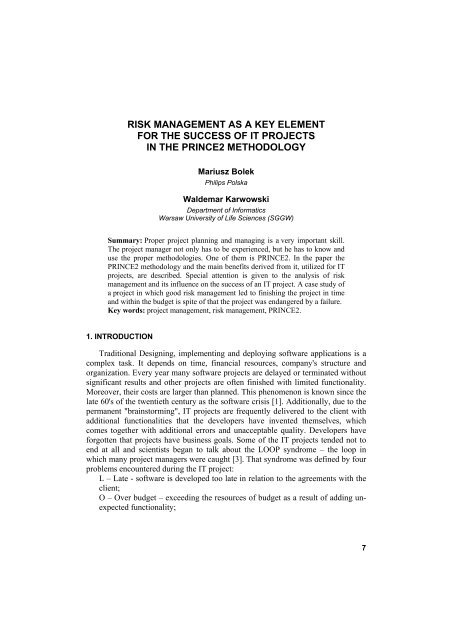INFORMATION SYSTEMS IN MANAGEMENT V - SGGW
INFORMATION SYSTEMS IN MANAGEMENT V - SGGW
INFORMATION SYSTEMS IN MANAGEMENT V - SGGW
Create successful ePaper yourself
Turn your PDF publications into a flip-book with our unique Google optimized e-Paper software.
RISK <strong>MANAGEMENT</strong> AS A KEY ELEMENT<br />
FOR THE SUCCESS OF IT PROJECTS<br />
<strong>IN</strong> THE PR<strong>IN</strong>CE2 METHODOLOGY<br />
Mariusz Bolek<br />
Philips Polska<br />
Waldemar Karwowski<br />
Department of Informatics<br />
Warsaw University of Life Sciences (<strong>SGGW</strong>)<br />
Summary: Proper project planning and managing is a very important skill.<br />
The project manager not only has to be experienced, but he has to know and<br />
use the proper methodologies. One of them is PR<strong>IN</strong>CE2. In the paper the<br />
PR<strong>IN</strong>CE2 methodology and the main benefits derived from it, utilized for IT<br />
projects, are described. Special attention is given to the analysis of risk<br />
management and its influence on the success of an IT project. A case study of<br />
a project in which good risk management led to finishing the project in time<br />
and within the budget is spite of that the project was endangered by a failure.<br />
Key words: project management, risk management, PR<strong>IN</strong>CE2.<br />
1. <strong>IN</strong>TRODUCTION<br />
Traditional Designing, implementing and deploying software applications is a<br />
complex task. It depends on time, financial resources, company's structure and<br />
organization. Every year many software projects are delayed or terminated without<br />
significant results and other projects are often finished with limited functionality.<br />
Moreover, their costs are larger than planned. This phenomenon is known since the<br />
late 60's of the twentieth century as the software crisis [1]. Additionally, due to the<br />
permanent "brainstorming", IT projects are frequently delivered to the client with<br />
additional functionalities that the developers have invented themselves, which<br />
comes together with additional errors and unacceptable quality. Developers have<br />
forgotten that projects have business goals. Some of the IT projects tended not to<br />
end at all and scientists began to talk about the LOOP syndrome – the loop in<br />
which many project managers were caught [3]. That syndrome was defined by four<br />
problems encountered during the IT project:<br />
L – Late - software is developed too late in relation to the agreements with the<br />
client;<br />
O – Over budget – exceeding the resources of budget as a result of adding unexpected<br />
functionality;<br />
7


